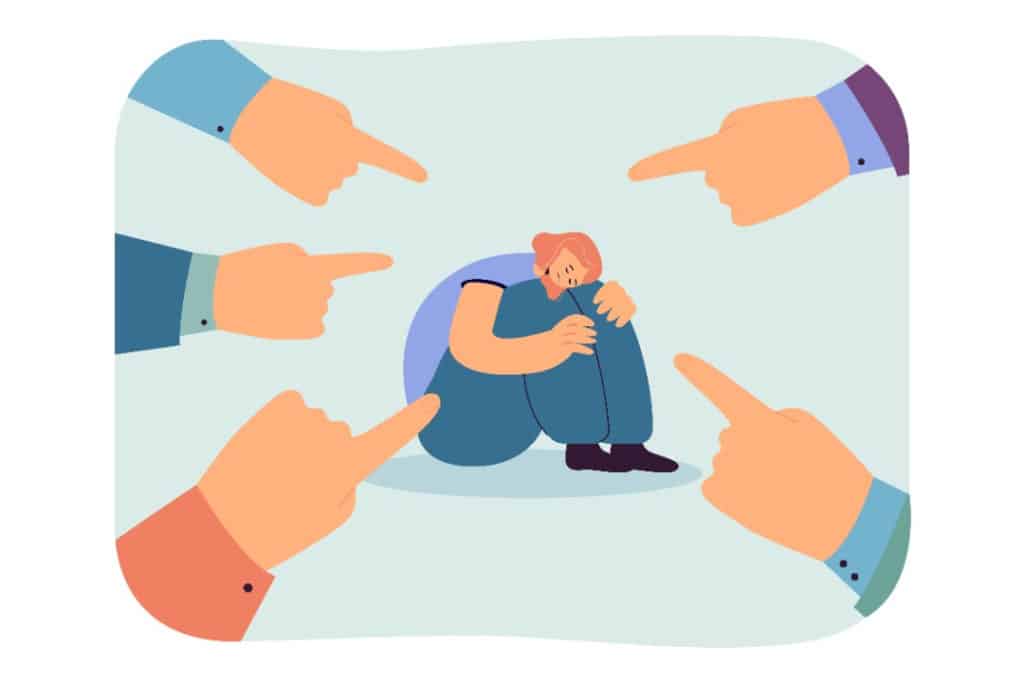Stigma is one of the most significant problems faced by someone struggling with a mental health diagnosis of any kind. When that diagnosis is related to disordered eating, the difficulties are often compounded and far more complex. Stigma inhibits one’s ability to seek help and interact with family, friends, or co-workers, and inevitably, leads to additional physical and mental health problems.
Eating disorders and other mental health struggles are frequently shrouded in secrecy and shame. People of all ages who have an eating disorder or mental health challenges such as depression, anxiety, or PTSD, experience isolation and loneliness. The struggles someone with an eating disorder faces around food and eating often lead them to distance themselves from friends and loved ones. Unfortunately, there is a strong stigma surrounding disordered eating that the struggles one experiences are voluntary or about vanity. This makes many people who could benefit from treatment at a skilled eating disorder treatment program actively avoid seeking help. Similar struggles plague people with other forms of mental illness as well.
What is Stigma?
Understanding how to remove stigma first requires understanding stigma. Stigma is defined as discrimination or a negative attitude against someone else based on a particular characteristic or condition. Common reasons people experience stigma are race, gender identity struggles, sexual orientation, religion, and mental illness.
Types of Stigma
Stigma linked to disordered eating and mental illness is often divided into two categories or types. The first type is called social stigma. These are the forms of stigma involving prejudiced attitudes others have towards mental illness. Social stigma consists of the disapproval of or discrimination against a person or group of people based on particular characteristics that appear to separate that person or group from other members of society. Social stigmas often involve race, illness, disease, culture, gender, etc.
The other type of stigma is self-perceived stigma. Self-perceived stigmas are feelings someone with an eating disorder or mental illness internalizes and uses against themselves. Self-stigmatizing behaviors can be more dangerous than the illness itself as they impact self-esteem, self-efficacy, and one’s overall outlook on life.
The Impact of Stigma
Stigma is not harmless. For some, the effects of stigma can be so overwhelming it leads to worsening mental health struggles or attempts at self-harm. The ongoing presence of stigma surrounding disordered eating and mental health highlights the lack of understanding society has of mental illness. People who struggle with stigma due to mental illness often experience a range of challenges, including:
- Bullying, harassment, or violence
- Reluctance to seek potentially life-saving treatment
- Worsening mental health symptoms
- Isolation, avoidance, and social rejection
- Increased feelings of self-doubt and shame
- Delayed treatment (which can lead to increased morbidity and mortality rates)
- Lack of understanding from friends and family
Tips for Reducing Stigma
For decades mental illness has been stigmatized around the world. Unfortunately, this chronic misunderstanding and misrepresentation of mental illness have led to ineffective and sometimes harmful treatments to address mental illness. Fortunately, the outlook on treating mental illness has changed, but the stigma has not entirely diminished. The only way to eliminate stigma is to continue fighting to help reduce the confusion and misunderstanding of mental illness.
First, it is essential to talk openly about mental health. Struggles with mental health and disordered eating are very common. Recent studies suggest disordered eating struggles impact at least 9% of the American population (approximately 29 million people). Also, 21% of American adults and 16.5% of youth ages 6-17 experienced mental health disorders in the past year. Sadly, mental illness remains the second leading cause of death among people between ages 10 and 34. Talking openly about mental health struggles and the challenges people with mental illness face is a vital step in reducing stigma.
Education is another crucial factor in eliminating mental illness stigma. The more people learn about mental illness, its symptoms, its impacts, and what it “means” to struggle with a mental health condition, the more likely people will understand stigma’s harmful and potentially dangerous outcomes. It is essential to show compassion and empathy for those with a mental illness.” Mental illnesses like disordered eating are complex conditions that often require comprehensive treatment and support at a treatment center like Toledo Center.
Education and understanding are key to overcoming stigma. The more people know about mental illness, the easier it will be to put stigmatizing behaviors in the past. If you or a loved one struggles with a mental health condition such as disordered eating, it is crucial to avoid self-stigmatizing behaviors. Connecting with a treatment center like Toledo Center is an essential step on your journey to lasting recovery. Reach out to our admissions team today to learn more about our compassionate, comprehensive Ohio treatment programs and how we can help.
Cites:
https://www.ncbi.nlm.nih.gov/pmc/articles/PMC8400545/
https://link.springer.com/article/10.1007%2Fs10488-012-0430-z
https://www.ncbi.nlm.nih.gov/pmc/articles/PMC3610943/
https://www.nami.org/Blogs/NAMI-Blog/February-2021/The-Many-Impacts-of-Self-Stigma
https://anad.org/eating-disorders-statistics/

